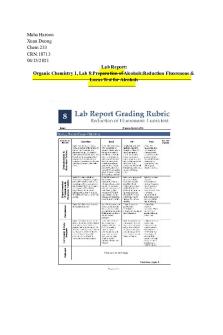Orgo 2 Lab 9 - Lab Report 9 PDF

| Title | Orgo 2 Lab 9 - Lab Report 9 |
|---|---|
| Course | Organic Chemistry II |
| Institution | Temple University |
| Pages | 4 |
| File Size | 330.9 KB |
| File Type | |
| Total Downloads | 74 |
| Total Views | 150 |
Summary
Lab Report 9...
Description
Experiment 34A: Oxidation of Methyl Ketones by the Haloform Reaction: Benzoic Acid Objective The purpose of this experiment is to explore the haloform reaction as a means of synthetically producing organic acids. For this reaction, we will perform the hypochlorite oxidation of methyl ketones with chlorine sourced from a basic aqueous solution of hypochlorite ions. Finally, the purity of the product will be examined using an IR spectra and by obtaining a melting point. Experimental Procedure Experiment 34A was followed as described in Mayo, pages 273-276, with the modifications listed in the Canvas document. Reaction Scheme
Calculations Theoretical Yield of Benzoic Acid Limiting Reactant [R] --- Benzoic Acid 90 μL 90 μL ×
1 𝑚𝑙 1000 µ𝐿
×
1.03 𝑔 1 𝑚𝐿
×
1 𝑚𝑜𝑙 𝑅 120.16 𝑔
×
1 𝑚𝑜𝑙 𝑃 1 𝑚𝑜𝑙 𝑅
×
122.12 𝑔 1 𝑚𝑜𝑙 𝑃
= 0.0942 grams --- 94 mg
Actual Yield of Benzoic Acid Weighed directly on weighing paper --- 66 mg of Benzoic Acid % Yield of Benzoic Acid (Experimental Yield / Theoretical Yield) x 100 = 66 𝑚𝑔 94 𝑚𝑔
x 100 = 70.21 ---- 70.2% Yield
Data and Results Compound
Mol. Weight (g/mol)
Amount
mmol
M.P. (℃)
B.P. (℃)
Density (g/mL)
Acetophenone
120.16
NaOCl Solution
90 μL
0.77
20.7
EY) 0.54 TY) 0.77
122.3
202.6
1.03
3.2 mL
Sodium Sulfite
126.04
37 mg
Benzoic Acid
122.12
EY) 66 mg TY) 94 mg
Observations ● Adding all reagents to the vial led to a clear liquid ● Addition of the ether resulted in two distinct layers, a top organic layer and bottom aqueous layer ● The addition of HCl as well as cooling via ice bath led to precipitation of a solid ● Final product appeared as a white crystalline powder ● Melting Point Range: 116.8 - 122.0 ℃, singularity at 117.2 ℃ Questions 1. Mechanism
2. Carbanion b) This carbanion is an acceptable leaving group because of the three chlorines. The electronegative attachments to the carbon act as
electron withdrawing groups and thus stabilize the molecule enough for it to function as a leaving group.
3. Reaction
4. a) Based on the IR, the desired product was formed. b) For benzoic acid, one would expect a broad band for the O-H stretch anywhere from 3300 - 2500 cm-1. Within the IR this is visible this broad stretch is visible from 3071 2554 cm-1, indicating the presence of an alcohol. Additionally, a carbonyl stretch should be visible around 1700 cm-1. This strong peak is present within the IR, to the left of the 1601 cm-1, but the exact wavenumber is cut off. Based on the presence of the alcohol and carbonyl peaks, it is reasonable to say a carboxylic acid formed, or in this case benzoic acid. 5. This NMR spectrum is consistent with acetophenone. Peak 1, the singlet at 2.18, is consistent with a 3 H methyl group. Acetophenone is the only material that has a methyl group (CH3) present as benzoic acid, and the haloform products are completely lacking this structure. Additionally, the number of hydrogens listed, eight, is only consistent with acetophenone. Benzoic acid would show six H’s, while the haloform would only show one H. Finally, benzoic acid would exhibit a distinct peak for the H located on the alcohol of the carboxylic acid. However, this is absent from the NMR. Based on this evidence, the only viable option for this NMR is acetophenone.
Works Cited Mayo, D. W.; Pike, R. M.; Forbes, D. C. Microscale Organic Laboratory with Multistep and Multiscale Syntheses, 5th ed.; John Wiley & Sons, Inc., 2011; pp 273-276. Modifications for Experiment 34A: The Haloform Reaction: Benzoic Acid, Canvas document....
Similar Free PDFs

Orgo 2 Lab 9 - Lab Report 9
- 4 Pages

Orgo lab 9 - Weekly lab 9
- 5 Pages

Lab Report 9 - lab
- 6 Pages

Chem lab 9 - lab report
- 3 Pages

Lab 9 Heredity Lab Report
- 10 Pages

Orgo 2 lab 4 - Lab report
- 14 Pages

Online Lab Report 9
- 7 Pages

Chem lab report 9
- 4 Pages

Orgo Post-lab 8 - Orgo- Lab report
- 14 Pages

Lab Report 9
- 7 Pages

Lab Report #9
- 7 Pages

Lab Report 9 Group
- 3 Pages

Lab Report #9
- 4 Pages

Lab Report 9
- 12 Pages

Lab 9 report
- 10 Pages
Popular Institutions
- Tinajero National High School - Annex
- Politeknik Caltex Riau
- Yokohama City University
- SGT University
- University of Al-Qadisiyah
- Divine Word College of Vigan
- Techniek College Rotterdam
- Universidade de Santiago
- Universiti Teknologi MARA Cawangan Johor Kampus Pasir Gudang
- Poltekkes Kemenkes Yogyakarta
- Baguio City National High School
- Colegio san marcos
- preparatoria uno
- Centro de Bachillerato Tecnológico Industrial y de Servicios No. 107
- Dalian Maritime University
- Quang Trung Secondary School
- Colegio Tecnológico en Informática
- Corporación Regional de Educación Superior
- Grupo CEDVA
- Dar Al Uloom University
- Centro de Estudios Preuniversitarios de la Universidad Nacional de Ingeniería
- 上智大学
- Aakash International School, Nuna Majara
- San Felipe Neri Catholic School
- Kang Chiao International School - New Taipei City
- Misamis Occidental National High School
- Institución Educativa Escuela Normal Juan Ladrilleros
- Kolehiyo ng Pantukan
- Batanes State College
- Instituto Continental
- Sekolah Menengah Kejuruan Kesehatan Kaltara (Tarakan)
- Colegio de La Inmaculada Concepcion - Cebu
